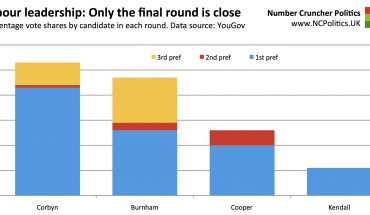The publication of the proposals for the new boundaries in England and Wales has reignited a debate that has been rumbling on, throughout this decade, about the fairness or otherwise of the process by which the United Kingdom is divided up into parliamentary constituencies. The debate has been short on evidence, so what I'm going to do here is to consider the validity of some of the claims being made.
As in any district-based electoral system, seats are created such that they all have roughly the same number of constituents. Because populations change over time, not least because of people moving home, boundaries have to be redrawn from time to time in order to maintain this balance. Long term demographic shifts (such as people moving out of city centres into the suburbs) mean that electorates in Labour-held constituencies tend to shrink over time, while Conservative consituencies tend to expand, meaning that equalising constituency sizes has always helped the Tories.
Historically these periodic reviews have generally been uncontroversial, apart from disputes about individual seats. It troubles me that boundaries are now becoming politicised, with a row (primarily) between Labour and the Conservatives, and both sides have been guilty of making questionable assertions.
The Conservatives have been justifying the seat reductions and accelerated timetable on the grounds of cost, which may have been a popular stance after the 2009 expenses scandal, but now sounds all-to-convenient. They have also been guilty of blaming boundaries for overall electoral bias (for example Labour winning 66-seat majority in 2005 with a 2.8-point lead but the Tories falling short in 2010 with a 7.3-point lead). Although boundaries do affect the skew, there were plenty of other things that have absolutely nothing to do with boundaries (such as differential turnout, tactical voting, contests with smaller parties) that hurt the Tories far more after 1987, and bundling them all together is highly misleading.
For their part, Labour have tended to talk about the disproportionate impact on their seat count as though it is inherently unfair on them. This is also misleading – they are losing more notional seats because their constituencies currently have much smaller electorates than Tory seats. In fact, Labour has had an advantage from unequal consitutency sizes at every election since 1955. There have also been suggestions that the boundary review singles out Labour-friendly urban areas and Wales, which omits the same vital context – those areas have too many seats to begin with (Wales, for historical reasons that pre-date devolution, has far too many).

The terms of reference that Parliament sets the boundary commisioners (the number of seats, the frequency of reviews and how strictly the quotas are applied) could be set in a number of different ways, with no single “right” answer, just several that are all defensible but affect the parties differently, and each side will inevitably prefer the remit that best suits its electoral prospects.
Aside from partisan self-interest, there is also a lot of misinformation (and bad reporting) about. In discussing this boundary review, many people (including some that should know better) have been conflating the fairness (or not) of this boundary review with other issues, like whether the population or the electorate should be used, and the (dis)proportionality of the first past the post electoral system.
Residents-versus-electors and electoral reform are both perfectly legitimate debates, but all boundary reviews in the past and the forseable future are on the basis of electorates and the current voting system. So neither discussion bears on whether this particular boundary review is more or less fair than any other.
The boundaries aren’t, as some have suggested, the government’s boundaries, but are drawn up by non-partisan boundary comissions in each constituent country of the UK, as is practice in Australia, Canada and some US states. However, the state senate disctricts in Massachusetts in 1812 certainty weren’t free from partisanship, and Governor Elbridge Gerry drew one so contorted that it looked like a salamander, hence the portmanteau gerrymander. Of course the term has recently been appropriated to mean just about anything psephologically objectionable, and seems to be misused more often than used correctly [rant over].
If you want to see what a real gerrymander looks like, this article from the Washington Post gives a shocking array of modern examples.
However there is one concern that does deserve serious consideration, and it relates to the electoral register used to determine consituency sizes. Between 1st December 2015 (the date used for the review) and 7th June 2016, the cutoff date for the EU referendum, registration increased by 2,058,456. Labour contend that using the older, slimmer version of the register leaves these two million disenfranchised, and have called for the newer, more complete version to be used instead. The newer electors aren’t disenfranchised in the literal sense, as they’re now registered and able to vote, but because they’re “ignored” in the figures used to apportion seats, the risk is that in reality the constituency sizes end up being unequal.
What matters for boundary-drawing purposes is not who these people would vote for – we don’t know that anyway – but where they live. The widespread assumption is that the two million newer registrations are disproportionately in urban areas with lots of students and transient renters – areas that reliably return Labour MPs.
But are they? I decided to do some analysis…
(Continued, please navigate using numbered tabs…)





